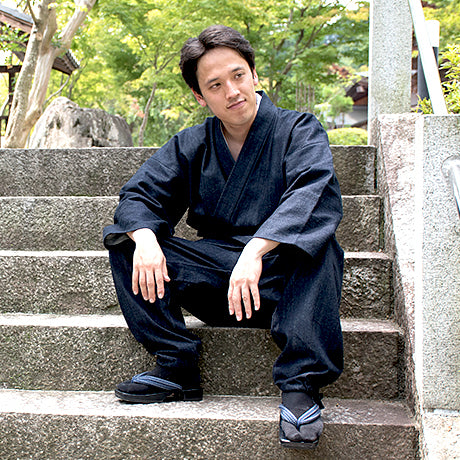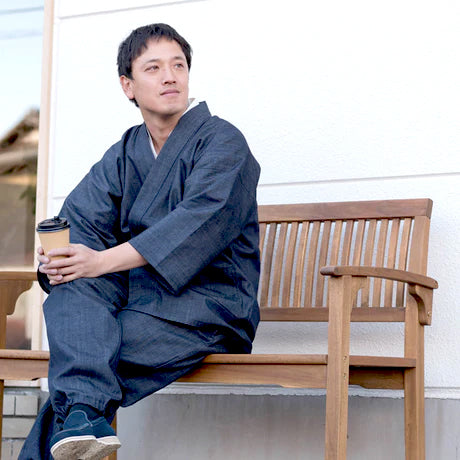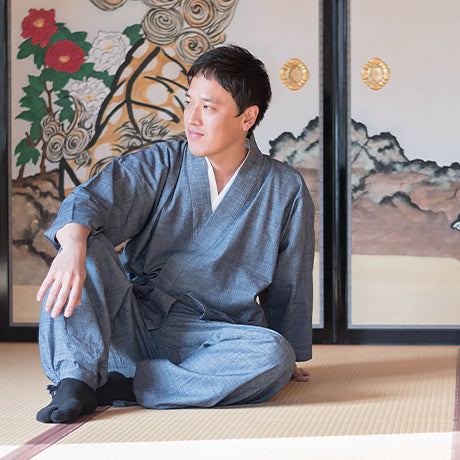KAIHARA Denim
Made-in-Japan Denim Fabrics Recognized Worldwide

One of the world’s leading denim fabric brands is located in Fukuyama City, Hiroshima Prefecture. The area has long flourished as a production center of Bingogasuri, and KAIHARA was also founded in 1893 as a weaving company producing hand-woven indigo-dyed kasuri. When weaving companies and clothing manufacturers asked KAIHARA to produce denim fabric by applying technology developed through the production of kasuri (patterned fabrics), KAIHARA made a major shift in its business from the production of kasuri to the production of denim fabric. In 1973, the company received an order from Levi’s and gained worldwide attention as a denim fabric manufacturer.
Evolution in Productions
The success of rope-dyeing, one of the dyeing techniques to dye the yarn which is used to weave denim fabric with indigo, opened the door to domestic denim fabric production, and KAIHARA continued to develop further. Establishing Japan's first integrated production system that handles all processes of denim fabric production, KAIHARA established weaving in 1978, fabric finishing in 1980, and spinning in 1991, thereby stabilizing the production of high-quality denim fabrics. Today, the company holds approximately 50% of the domestic market share, and exports to more than 30 countries.
KAIHARA's strength lies in its ability to combine old and new technologies, such as utilizing old-fashioned shuttle looms while actively introducing state-of-the-art equipment, just as it has done in the past with the technology that came out of its earliest developments in the field of kasuri. KAIHARA, which carries this spirit of tradition and innovation, is recognized as one of the world's top brands of high-quality denim.
By the way, one of our colleagues is experimenting with how the indigo color fades and changes its colors. It is truly fascinating to see the beautiful transformation of denim samue! Now, let’s take a look at his article!
[Kaihara Denim Samue in its Fifth Year]

“I would like to introduce one of our popular denim samue, "Kaihara Denim 11oz," titled "5 years old Kaihara Denim Samue" from the viewpoint of color fading and, using some photos, how it looks after wearing it for many years. Since we often receive inquiries about how the color changes over time, it is a good opportunity for me to write about it.
Denim Items Related to this Article
As of January 2020, the Kaihara Denim Samue series, created in collaboration with a wonderful denim manufacturer that is, so to speak, the "representative of blue denim in Japan," has three types of items in production.
5090 Kaihara Denim 11oz Samue
First-generation Kaihara Denim. Reliable even in the cold winter months.
In 2023, we released 5083 KAIHARA DENIM 11oz Samue [Kai]
Modified the pants so that they do not to fall over time
5095 KAIHARA DENIM Pima Cotton Samue
Silky and shiny Pima cotton. You can wear it all year round.
5085 Kaihara Denim Chambray Indigo Dye Samue
Unique marbled texture. Perfect for spring and summer.
Charms of Indigo Dye
One of the charms of these samue is the "color fading" that is unique to indigo dyeing. I have been wearing the 11 oz samue as my cold weather work clothes since the winter of 2015, and this year will be the 5th year I have worn it.
I used to wash them by hand once every two to three weeks, or if that was too much trouble, I washed them in the washing machine. When using a washing machine, I wash it alone to avoid dye transfer. Here are some pictures of how it turned out.

I placed them on the white floor and lined them up.

The left, or bottom, is the unwashed sample, and the right, or top, is my 5-year-old samue. I tried to take a picture with the right side up.
I also took a picture of the two samue together.
Cherishing and Caring
Although the light has slightly changed the color of the image, I think you can tell that it has changed a lot. I think it has a nice taste. It's like a parent's delight in their child's growth (lol).
The fabric has become softer and softer with each wash and has a gentle texture. By the way, the color is still in the process of fading! I will continue to enjoy the changes as I go along with this samue.
That's all for this report. Thank you very much for your time.”
Now, if you become interested in the process of color fading of indigo dyeing, why not try to see for yourself? I'm sure you will be amazed by the beautiful transformation of these samue and want to love them more.



